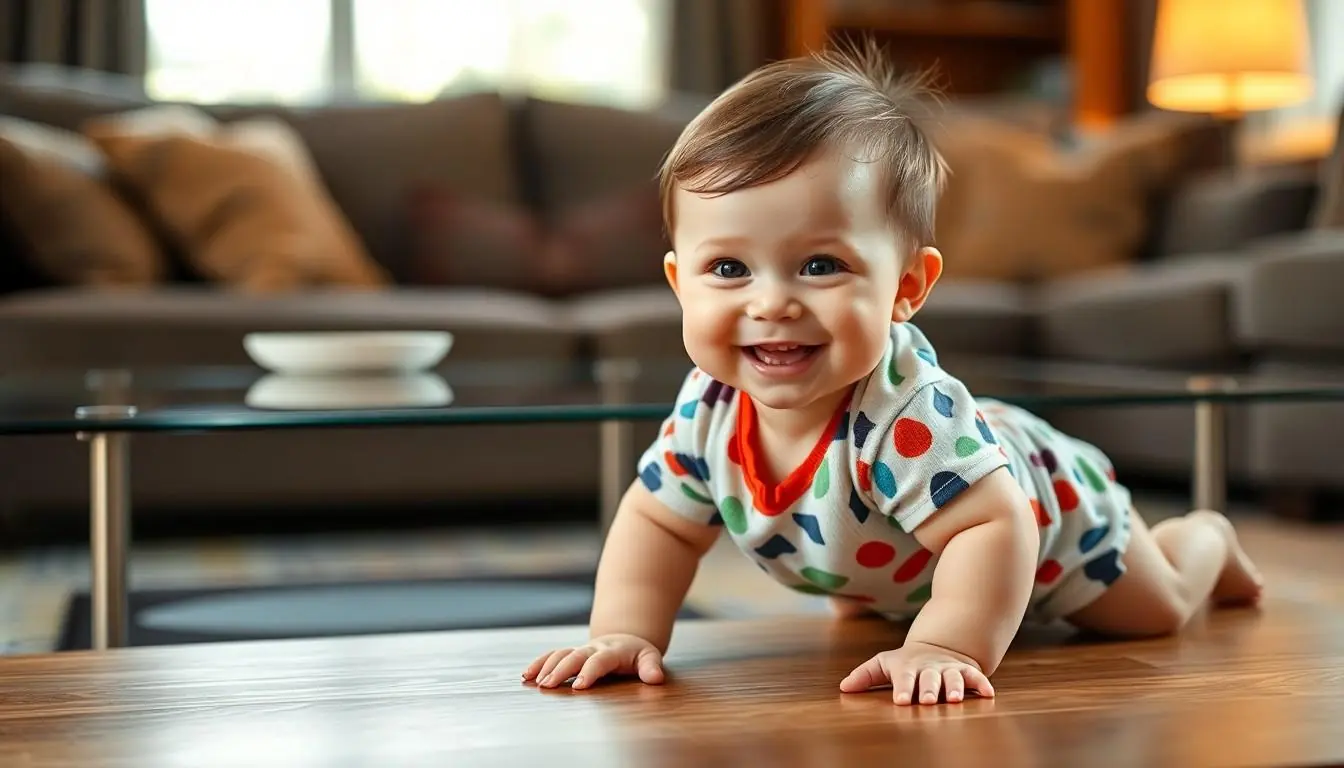Watching a baby transform from a wobbly little bundle to a curious explorer is nothing short of magical. One moment they’re contentedly playing on the floor, and the next, they’re pulling themselves up like a tiny gymnast ready for the big stage. But when does this acrobatic feat actually happen?
Table of Contents
ToggleUnderstanding Baby Development Milestones
Developmental milestones play a crucial role in tracking a baby’s growth. Around six to 10 months, many babies begin the challenging task of pulling themselves up to a standing position. This action showcases their muscle strength and coordination.
During this period, babies start to explore their environment from an upright perspective. They often use furniture, such as couches or low tables, as support while ascending. Such support helps develop their balance and grasp reflexes.
Observing a baby pull themselves up is exciting, as it often precedes walking. Many parents notice their child transitioning from sitting to standing, signaling an eagerness for exploration. Some babies achieve this milestone earlier, while others may take longer, reflecting individual differences in development.
Motor skills evolve rapidly. Initially, a baby may pull up and then immediately lower themselves. With practice, they become more adept, gaining confidence and stability. This journey not only involves physical growth but also cognitive advancements. Understanding spatial relationships becomes clearer as babies learn to navigate their surroundings.
Interacting with a baby during this stage enhances their learning experience. Activities like encouraging them to stand while holding onto a sturdy object promote muscle development. A baby’s ability to pull themselves up varies, but typically, they’ll reach this milestone within their first year. Tracking progress can provide insight into their overall development.
Typical Age Range for Pulling Up

Most babies begin pulling themselves up between six to ten months of age. This period marks significant growth in muscle strength and coordination, allowing them to explore their world from an upright position.
Individual Variations in Development
Development varies significantly among babies. Researchers note that some infants may pull themselves up as early as five months, while others might not achieve this until after ten months. Factors such as physical development, temperament, and personality all contribute to these differences. Parents should remember that each baby’s journey is unique, so comparisons among peers can be misleading.
Factors Influencing Timing
Several factors influence when a baby pulls themselves up. Physical development plays a crucial role, with stronger muscles enabling this milestone. Access to safe environments also encourages exploration, as babies who engage with their surroundings tend to develop skills sooner. Additionally, parental interactions, like encouraging standing using stable furniture, foster earlier abilities. Genetics can further impact timing, as some babies naturally progress through milestones at different paces.
Signs Your Baby is Ready to Pull Themselves Up
Recognizing signs of readiness helps parents support their baby’s development effectively. Observing a few indicators can signal when a baby is ready to pull themselves up.
Physical Signs
Strength in a baby’s muscles becomes evident as they approach this milestone. A baby may demonstrate increased leg and arm strength, showing the ability to support their weight. Furthermore, frequent attempts to push their body forward from a seated position often occur. Additionally, reaching for furniture and toys while standing helps enhance stability and coordination. Grasping furniture and pulling at it provides support and encourages exploration from a standing position. These movements indicate growing confidence and readiness to pull up.
Behavioral Cues
Excitement during playtime often signifies a baby’s eagerness to explore their environment. A baby may show curiosity by moving towards objects within their reach. Frequent shifting from sitting to crawling positions might also suggest readiness. Repeating the process of pulling up reinforces muscle memory and motor skills over time. Observing a baby’s reactions to sound and light can reveal their determination to rise and engage more actively with the world. Seeking comfort from parents or caregivers also amplifies their confidence during the transition to standing.
Safe Environment for Pulling Up
Creating a safe environment is crucial as babies begin to pull themselves up. Ensure the area is free of sharp objects and choking hazards, allowing babies to explore without fear of injury. Anchoring furniture can prevent tipping, a common risk when babies use items for support. Soft rugs or padded mats provide comfort during falls, cushioning their landing.
Removing obstacles from the baby’s path encourages independent movement. It’s essential to keep frequently used toys within reach, motivating babies to stand and grasp them. Sturdy furniture offers the best support; items like low tables or couches assist in building strength and balance. Space for movement promotes confidence, allowing babies to practice standing without restrictions.
Overseeing babies during this phase matters significantly. Supervising them prevents accidents and encourages exploration. Parents and caregivers can provide gentle support, guiding them as they learn to navigate their surroundings. Engaging with babies helps them feel secure, fostering a positive learning experience.
Modeling safe behaviors also teaches them effective pulling up techniques. Demonstrating how to use furniture properly reinforces these skills. Positive reinforcement, such as clapping or verbal praise, boosts their confidence as they succeed at pulling up.
Monitoring the environment continuously ensures ongoing safety. Regularly inspect the play area for new hazards, especially as babies become more mobile. Maintaining a clutter-free space allows for safe practice and exploration, ultimately supporting their developmental milestones during this exciting stage.
Watching a baby pull themselves up is a thrilling experience that marks a significant step in their development. This milestone not only showcases their growing strength and coordination but also opens up new avenues for exploration and learning. Each baby’s journey is unique and influenced by various factors, making it essential for parents to celebrate their child’s individual progress without comparison.
Creating a safe environment for practice is crucial as they navigate this exciting phase. With the right support and encouragement, babies gain confidence while developing essential skills that lay the groundwork for future milestones like walking. Embracing this journey with patience and positivity will foster a nurturing atmosphere for growth and discovery.


